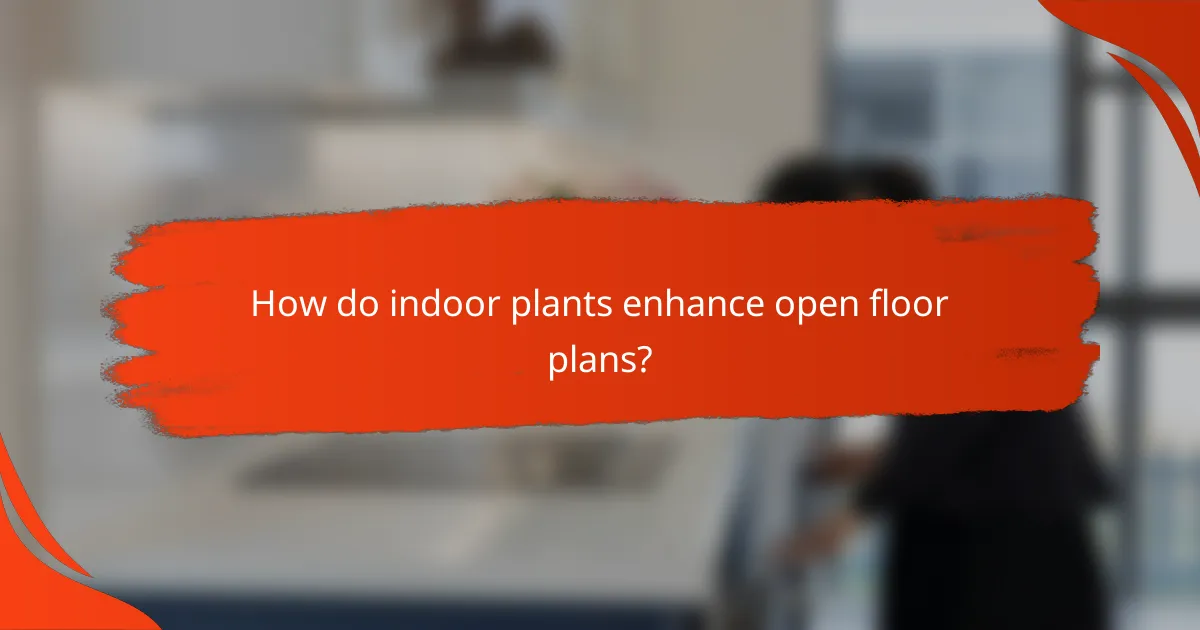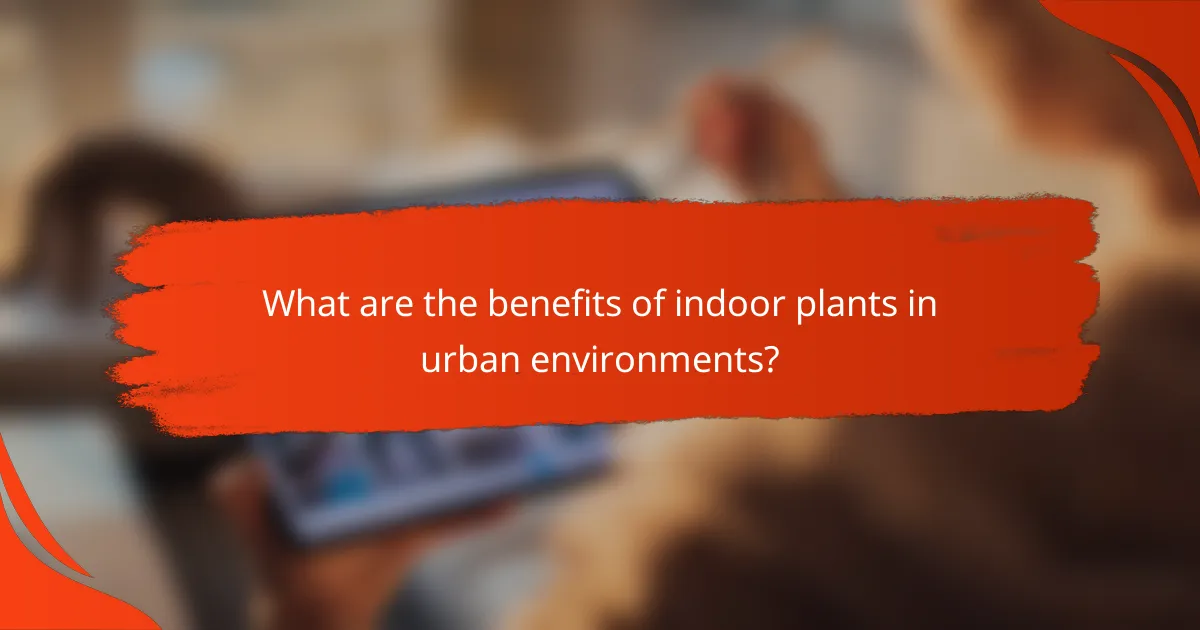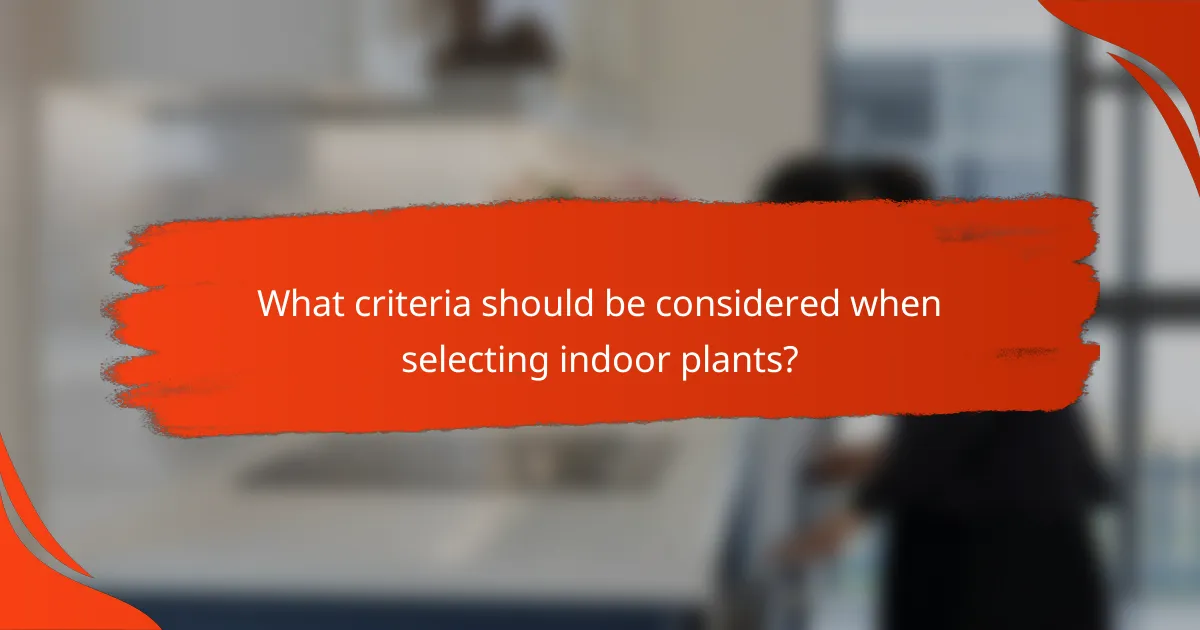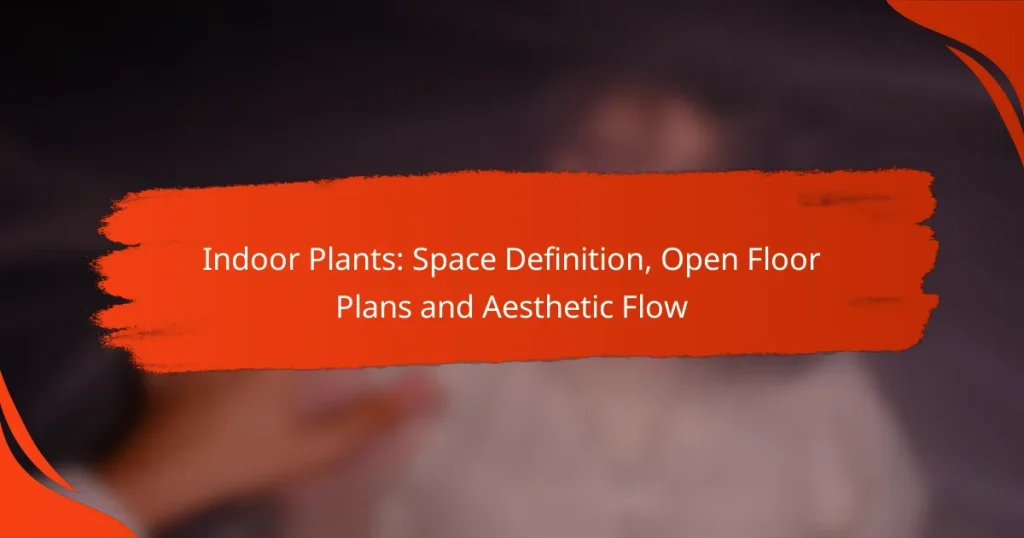Indoor plants play a crucial role in enhancing open floor plans by improving air quality and adding aesthetic value. By strategically selecting and arranging plants, you can create a harmonious atmosphere that transforms spacious areas into inviting environments. Thoughtful placement and variety in height can further enhance the visual flow, making your home feel vibrant and cohesive.

How do indoor plants enhance open floor plans?
Indoor plants significantly enhance open floor plans by improving air quality, creating visual separation, and adding aesthetic value. Their presence can transform a spacious area into a more inviting and functional environment.
Improved air quality
Indoor plants contribute to better air quality by absorbing carbon dioxide and releasing oxygen. Many species can also filter out common indoor pollutants, such as formaldehyde and benzene, making the air healthier to breathe.
To maximize air purification, consider incorporating a variety of plants known for their filtering capabilities, such as spider plants, peace lilies, and snake plants. Aim for at least one plant per 100 square feet for noticeable benefits.
Visual separation of spaces
Plants can effectively delineate different areas within an open floor plan without the need for physical barriers. Strategically placed potted plants or vertical gardens can create distinct zones for dining, working, or relaxing.
Using taller plants like fiddle leaf figs or bamboo can enhance this effect, providing a natural boundary while maintaining an airy feel. Grouping smaller plants on shelves or tables can also help define spaces subtly.
Increased aesthetic appeal
Incorporating indoor plants adds a vibrant touch to open floor plans, enhancing overall aesthetic appeal. Their diverse colors, shapes, and textures can complement various design styles, from modern to rustic.
Choose plants that align with your decor theme; for instance, succulents work well in minimalist designs, while lush ferns suit bohemian styles. Regularly updating plant arrangements can keep the space feeling fresh and lively.
Boosted mood and productivity
Having indoor plants in an open floor plan can positively impact mood and productivity. Studies suggest that greenery can reduce stress and enhance focus, making spaces more conducive to work and relaxation.
To harness these benefits, consider placing plants in areas where you spend significant time, such as home offices or reading nooks. Simple additions like a small desk plant or a few hanging pots can create a more uplifting atmosphere.

What are the best indoor plants for aesthetic flow?
The best indoor plants for aesthetic flow enhance the visual appeal of a space while promoting a sense of harmony. Selecting plants that complement your interior design can create a cohesive atmosphere, making your home feel more inviting and vibrant.
Fiddle Leaf Fig
The Fiddle Leaf Fig is known for its large, glossy leaves that can add a dramatic touch to any room. This plant thrives in bright, indirect light and can grow quite tall, making it a striking focal point in open floor plans.
When caring for a Fiddle Leaf Fig, ensure it receives adequate moisture without becoming waterlogged. A well-draining potting mix and occasional fertilization during the growing season can promote healthy growth.
Snake Plant
The Snake Plant, or Sansevieria, is an excellent choice for those seeking low-maintenance greenery. Its upright, sword-like leaves can add vertical interest to your decor while thriving in various lighting conditions, from low light to bright indirect light.
This hardy plant requires minimal watering, making it perfect for busy lifestyles. Allow the soil to dry out between waterings to prevent root rot, and consider placing it in a decorative pot to enhance its aesthetic appeal.
Peace Lily
The Peace Lily is celebrated for its elegant white blooms and glossy green leaves, making it a popular choice for enhancing aesthetic flow. It prefers low to medium light and can thrive in humidity, making it suitable for bathrooms or kitchens.
To care for a Peace Lily, keep the soil consistently moist but not soggy. Regularly wiping the leaves can help maintain their shine and remove dust, ensuring the plant remains visually appealing.
Pothos
Pothos is a versatile trailing plant that can adapt to various environments, making it ideal for creating a lush, cascading effect in your home. Its heart-shaped leaves come in various colors, adding a dynamic element to your decor.
This plant thrives in low to bright indirect light and can tolerate occasional neglect. Regular pruning can encourage bushier growth, and using a trellis or hanging planter can enhance its aesthetic flow throughout your space.

How to arrange indoor plants in an open space?
Arranging indoor plants in an open space involves creating a balanced and visually appealing layout that enhances the overall aesthetic. Consider factors such as plant height, placement, and the flow of the space to achieve harmony and functionality.
Grouping plants by height
Grouping plants by height helps create a layered look that adds depth to your space. Place taller plants at the back or center and shorter ones in front or around them to ensure visibility and accessibility. This arrangement not only draws the eye but also allows for better light distribution among the plants.
For example, consider using tall floor plants like fiddle leaf figs or snake plants as focal points, surrounded by medium-sized plants such as pothos or peace lilies, and finishing with smaller plants like succulents or herbs. This variety in height creates an engaging visual experience.
Using plant stands
Plant stands are an effective way to elevate plants and create visual interest in an open space. They can help maximize floor space and allow for better light exposure, especially in areas with limited natural light. Choose stands that complement your decor style, whether modern, rustic, or minimalist.
When selecting plant stands, consider varying the heights and styles to create a dynamic arrangement. For instance, a combination of a tall stand for a rubber plant and a low stand for a collection of smaller pots can enhance the overall aesthetic flow.
Creating focal points
Creating focal points with indoor plants can significantly enhance the visual appeal of an open space. Identify areas where you want to draw attention, such as corners or entryways, and place a striking plant there. Large, unique plants like a monstera or a bird of paradise can serve as excellent focal points.
Additionally, consider grouping smaller plants around the focal point to create a cohesive look. This approach not only highlights the main plant but also adds layers and textures to the space. Ensure that the focal point complements the overall design and color scheme of the room for a harmonious effect.

What are the benefits of indoor plants in urban environments?
Indoor plants offer numerous benefits in urban settings, including improved air quality, enhanced aesthetics, and psychological well-being. They can transform spaces, making them more inviting and comfortable while contributing to a healthier living environment.
Noise reduction
Indoor plants can significantly reduce noise levels in urban environments, acting as natural sound barriers. They absorb, deflect, or refract sound waves, which can be particularly beneficial in busy city areas where noise pollution is prevalent.
To maximize noise reduction, consider using larger plants with dense foliage, such as rubber trees or peace lilies, as they tend to be more effective. Placing plants strategically near windows or walls can further enhance their sound-absorbing capabilities.
Microclimate regulation
Indoor plants help regulate the microclimate within urban spaces by maintaining humidity levels and improving air quality. They release moisture through a process called transpiration, which can create a more comfortable atmosphere, especially in dry indoor environments.
Incorporating a variety of plants can enhance this effect. For instance, ferns and spider plants are known for their humidity-boosting properties, while succulents can help maintain a balanced environment in drier areas. Regularly watering and caring for these plants ensures they continue to provide these benefits.
Enhanced privacy
Indoor plants can enhance privacy in urban homes by creating visual barriers that obscure views from outside. Tall plants or strategically placed arrangements can block sightlines, making living spaces feel more secluded and intimate.
To achieve effective privacy, consider using taller plants like dracaenas or bamboo palms. Grouping plants together can also create a lush, green screen that adds both beauty and seclusion to your indoor environment. Regular maintenance will keep these plants healthy and visually appealing.

What criteria should be considered when selecting indoor plants?
When selecting indoor plants, consider factors such as light availability, humidity levels, and the size of the space. These criteria will help ensure that the plants thrive in your environment and enhance the overall aesthetic of your home.
Light Requirements
Different indoor plants have varying light needs, ranging from low to bright indirect light. Assess the natural light in your space by observing how sunlight enters throughout the day. For example, succulents and cacti prefer bright light, while ferns and snake plants can tolerate lower light conditions.
To maximize plant health, position them according to their light requirements. Use sheer curtains to diffuse harsh sunlight for sensitive plants, and consider rotating them periodically for even growth.
Humidity Levels
Indoor humidity can significantly impact plant health, especially for tropical varieties. Most indoor environments have humidity levels between 30-50%, which may not be ideal for plants like orchids or peace lilies that thrive in higher humidity. Using a humidifier or placing a tray of water near your plants can help increase moisture levels.
Monitor humidity with a hygrometer to ensure your plants are comfortable. If the air is too dry, consider grouping plants together to create a microclimate that retains moisture.
Space Size and Layout
The size and layout of your space will influence the types and number of plants you can incorporate. Larger plants, such as fiddle leaf figs, require more floor space and can serve as focal points, while smaller plants, like pothos or spider plants, can fit on shelves or tables. Assess your available space to avoid overcrowding.
Consider the flow of your layout as well. Ensure that plants do not obstruct pathways or natural light sources. Using plant stands or wall-mounted planters can help optimize space while maintaining aesthetic appeal.


